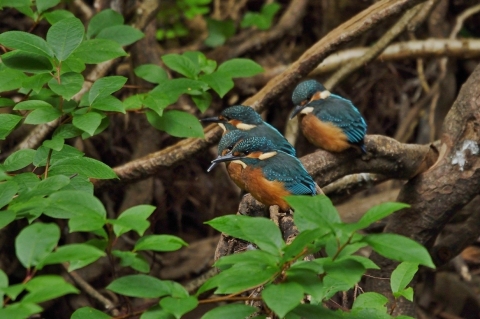
Jeff Chard

Jeff Chard
Like many, many other wildlife enthusiasts in Wales, my wildlife spotting during lockdown was initially restricted to home, in my not-so-wildlife-friendly garden. More recently I ventured a little further afield, to the River Rhymney, a five minute walk away and then another five minute walk to a meadow, where a farmer has given me permission to watch one of my favourite mammals.
Even though the enclosed garden of our terraced house, is not wildlife friendly, I was surprised by what visited, what I could find on walls and plants and also what I could simply observe above, when sitting on the patio.
A variety of insects crawled and flew about me, including Ladybirds, spiders, Green shield bugs, beetles, bees, the occasional butterfly, an array of hover flies, even ants and woodlice were pleasant distractions from the constant threat of Covid-19.
Jackdaws, Magpies and House Sparrows have been ever present and I’ve counted seven Sparrows’ nests amongst the eaves of our nearest neighbours, including one in our house. Their constant chirping and chattering rising to raucous alarm, at least twice, as a sparrow hawk patrolled overhead.
Other raptors have passed by, including red kites, a peregrine falcon and numerous Buzzards can regularly be seen, spiralling on thermals above the valley. Best of all the feathered friends that grace the skies around our village, have been the swifts that I first spotted in late April. To my delight they have nested in next door’s eaves, for the first time in the 42 years that we’ve lived in our house. Fantastic to watch their aerial acrobatics and their “screaming parties” with another two local pairs, have been glorious to hear.
As soon as restrictions were relaxed, I headed for a stretch of my local river. I gained permission to explore the riverbank along a field and on the very first day I not only discovered evidence of Otters, but I also spotted a pair of Kingfishers that were carrying fish, heads forward, an indication that they were feeding chicks somewhere. Fortunately, I discovered that the nest was along the stretch I could access, high in the far bank.
Similar to Otters, Kingfishers are a protected species, so I quickly obtained the cover of a Schedule 1 licence to be able to study them and gather material for future talks. Over the past month or so, I’ve spent over 100 hours isolated under camouflage, watching these majestic birds until the emergence of four delightful fledglings. Other wildlife, such as Dippers, Wagtails, Wrens and even fish kept me company during my vigil! However, I’ve not yet spotted the Otter and it has managed to avoid the trail camera I’ve occasionally set at a regular sprainting site. I shall persevere though.
Aside from my study of the Kingfishers, I’ve visited a Badgers’ sett on five occasions during lockdown. It’s a sett that I’ve helped others to monitor over the past three years and I was concerned during early lockdown, that no one was able to visit to check on the Badger family. The cattle farmer is a wildlife lover and is keen to keep the family safe at the sett, as they are free from infection. I needn’t have worried, as my most recent visit proved that a family of five are doing well, along with a resident wood mouse and a local vixen.
I appreciate there’s more to wildlife than just Otters. Wildlife abounds all around us, near and far but, as thrilling and wonderful as these local wildlife experiences have been (and they have certainly brightened my days), Otters remain my firm favourite and I’m eager to return to otter spotting at my usual locations, as soon as it is safe to do so. However, if I can manage to establish the movements of my local Otter, I may not have to travel far.
For the moment, stay local, stay safe and trust wildlife to help you through.

Fox photographed by Jeff Chard